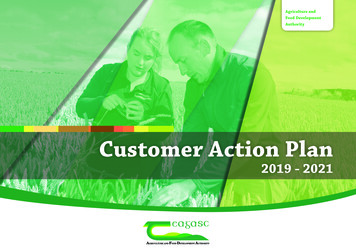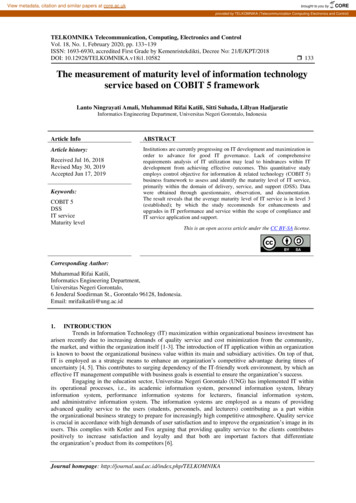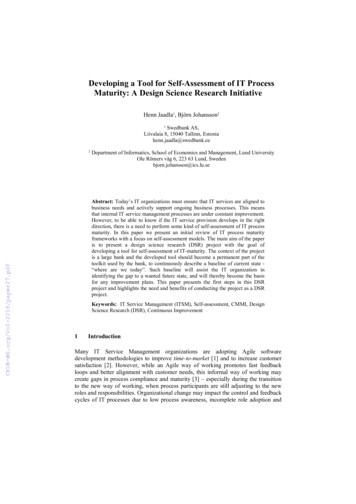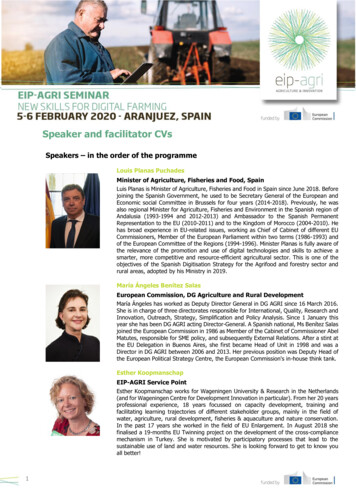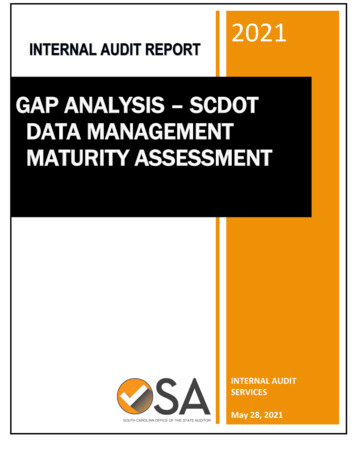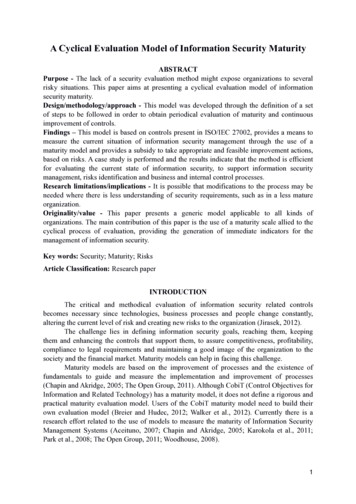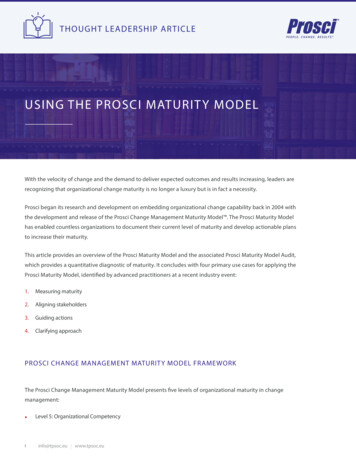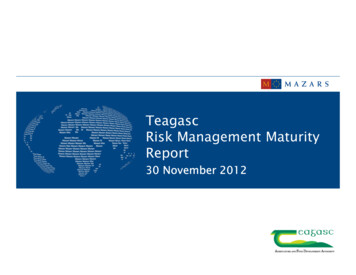
Transcription
TeagascRisk Management MaturityReport30 November 2012
TABLE OF CONTENTS1.2.INTRODUCTION1.1Background to the Review1.2Desk Based Review of Documentation1.3Identification of Risk Maturity Themes1.4Meetings with Management and StaffRISK MANAGEMENT MATURITY OF TEAGASC2.1. Risk Management Maturity - Introduction2.2. Risk Management Maturity – Observations by Theme2.2. Risk Management Maturity – Recommendations by Theme
1.INTRODUCTION1.1 Background to the ReviewTeagasc engaged the support of Mazars to independently assessthe risk management function within Teagasc and MTL. Theresults of the review within MTL are covered under a separatedocument.Teagasc, the Agriculture and Food Development Authority, is thenational body responsible for providing integrated research,advisory and training services to the agriculture and foodindustry and rural communities in Ireland. Teagasc is requiredunder the 2009 “Code of Practice for the Governance of StateBodies” to carry out an external review of the effectiveness of itsrisk management framework on a periodic basis. This is the firstsuch review.The approachinvolved:A risk management function with numerous levels, such as thatused by Teagasc, assists in enforcing accountability andresponsibility across a number of levels in the Organisation.Such delegation of responsibility assists in creating a strong riskand control culture.incompletingthisassignment1.Desk based review of Teagasc risk policies, risk registersand other documents pertinent to the review2.Identification of maturity themes which would be used tosupport the assessment. These themes were identifiedbased on consideration of Teagasc priorities as per thetender document and common risk management themesincluded in guidance documents such as the Code ofPractice for the Governance of State Bodies (2009), ISO31000, the 2003 Working Group Report on theAccountability of Secretaries General and AccountingOfficers,Department of Finance Guidelines, NWA31000:2010 and BS31100:2011.3.Meetings with Teagasc management and staff involved invarious aspects of risk management across theorganisation4.Assessment of risk maturity levels across each of theassessment themes based on the outputs of the deskbased review and meetings with relevant managementand staffOver the past four years the risk profile of Teagasc has changedconsiderably. Teagasc is now operating in an environmentcharacterised by reduced funding and limitations on resources(through the moratorium on recruitment). At the same time therequired activity level of the Organisation has been maintained.In this context, the importance of having a well developed riskmanagement function is heightened, as such a function assistsmanagement and the Authority in providing transparency overmajor organisational threats (and opportunities), prioritising therisks that require urgent attention and ensuring that risks, alongwith their associated controls and actions are adequatelymanaged over time.adoptedThe approach is further outlined in sections 1.2 – 1.5below1
1.2 Desk Based Review of DocumentationA large number of documents were issued and reviewed byMazars in support of the assessment. The desk based review ofdocumentation supported Mazars in gaining insight into thepractical operation of risk management in Teagasc. Initialobservations on maturity were identified and theseobservations were discussed as part of the management andstaff meetings to support the maturity assessment.The Risk Management Maturity Continuum and the sixthemes identified to support the assessment are presented asfigures 1 and 2 on the following pages. The features of eachtheme in terms of maturity levels is provided in figure 3.1.3 Identification of Risk Maturity ThemesIn evaluating the effectiveness of the Teagasc riskmanagement frameworks, the Mazars Risk ManagementMaturity Continuum (“RMMC”) formed the cornerstone of ourmethodology.The RMMC describes an improvement path from an ad-hoc,immature Risk Management function to a mature, disciplinedfunction focused on continuous improvement. The modelconsists of a continuum of five risk management maturitylevels, which allows the reviewer to rate the state, or maturityas Initial, Repeatable, Defined, Managed or Optimizing.To support the RMMC and the detailed assessment of riskmaturity, we identified 6 assessment themes. In doing so weconsidered the priorities outlined in the tender document,and the requirements included in risk management guidancedocuments.2
Figure 1: Overview of the Risk Management Maturity ContinuumThe continuum and attributes below were used to support the assessment. Each of the six themes was examined though deskbased review and meetings with relevant management and staff to rate the state, of maturity as Initial, Repeatable, Defined,Managed or Optimizing.3
Figure 2: Overview of Risk Maturity Themes used to support the assessmentThe six themes below were used to support the assessment. Each of the six themes was examined and rated in terms of amaturity level of Initial, Repeatable, Defined, Managed or Optimizing. They are further described in terms of features of maturityin figure 3.Risk ManagementCultureRisk ManagementStrategy and PolicyRisk Management StructuresRisk Management ProcessesRisk Management MethodologiesRisk Management Systems4
Figure 3: Features of Maturity by ThemeThemeKey characteristicsCultureRisk culture reflects the degree to which the principles of risk management are embedded across theorganisation. Features of a mature risk culture include;1. Management and staff involved in risk management have a common understanding of the necessity of riskmanagement and the benefits arising2. Management and staff have been trained on the principles of risk management and the application ofstandards3. Management and staff consistently understand and embrace both formal and informal risk managementprocesses and understand the relationship between these processes4. Risk management competencies are included in job descriptions and appraisals measure the degree towhich risk management responsibilities have been met5. Managers feel a sense of responsibility towards the risks and related mitigating controls relating to theirareas6. Managers provide assurance on the effectiveness of their risk identification and ongoing management ofrisks7. A culture of risk escalation exists8. Risk and risk management is part of the regular process for each department and is regularly discussed atmeetings9. Terminology used in relation to risk management is consistentStrategy Risk strategy and policy reflect the degree to which the longer term direction and scope of risk management areand Policy established and the adequacy of the documented policy.policy. Features of maturity include:1. A risk management strategy exists which defines the short, medium and long term objectives for riskmanagement and the strategy and is approved by the Authority and other appropriate groups2. The risk management strategy is supported by a risk management policy which appears complete3. The risk management policy is appropriately approved and reviewed4. The risk management policy sets out the risk appetite of the organisation and tolerance levels for acceptableand unacceptable risk5. The risk management policy defines the framework, structures, responsibilities, processes, methodology andsystems and tools used to manage risk6. The risk management policy is readily available to staff5
ThemeStructuresKey characteristicsRisk structures are used to support risk management processes. They include the individuals and groups responsible forcoco-ordinating managing and monitoring the risk management processes. Features of a maturity include:1. Risk management structures have been defined at all levels2. Risk management structures are aligned to structures already in place3. Meeting frequency and level of involvement from each structure has been defined and appears to be appropriate4. Responsibilities for each structure have been defined and terms of reference / job descriptions updated appropriately5. The framework includes appropriately skilled resources across the operational aspects of risk management as well asoverseeing the adequacy of the function6. Ownership of risks has been clearly defined, assigned and acknowledged and risks have been allocated to specific jobtitlesProcessesRisk management processes are well defined in order to identify, assess, treat, monitor and update the risk register and riskmanagement processes integrate with other business processes. Features of maturity include;1. Risk management processes allow for the portfolio view and management of risks including monitoring of any changes2. The risk framework supports integration with other functions and processes such as business planning, strategy andinternal audit3. Processes have been defined to identify and update the risk register and these have been followed at each level4. Risk identification includes consideration of internal and external risk drivers and risk events are logged to support linkagewith risk management processes5. Risk registers are completed to similar standard across the organisation and across levels6. The application of the risk management methodology results in the inclusion of an appropriate number and range of riskson the risk registers7. A process exists to ensure that new risks are identified and reported in a timely manner8. The risk register is updated in a meaningful manner on an ongoing basis9. Guidance provided to support the risk management process is consistent and effective10. The linkage between risk registers is clearly defined and works well in practice6
ThemeKey characteristicsMethodology Risk management methodology refers to the adequacy of tools, templates and techniques used to support the riskmanagement processes including whether methodologies are consistently applied across the organisation. It spans accessrisk identification, assessment, management, review and reporting. Features of maturity include;1. A defined risk management methodology is in place and appears appropriate to support the processes of riskidentification, assessment, management, review and reporting2 The risk management methodology is consistently followed3. Risk identification is approached in a methodical way to ensure all significant activities within the organisation andassociated risks have been defined4. Identified risks are mitigated in a timely fashion, based on the level of associated impact and likelihood, in relation to therisk appetite5. The management of identified risks involves consideration of the appropriate response i.e. tolerate, treat, terminate,transfer6. Risk reporting takes place at difference levels within the organisation to reflect the need for different information fromthe risk management processRiskRisk systems refers to the IT systems in place to support risk management processes and methodologies. Features ofManagement maturity include;Systems1. Appropriate IT systems are leveraged to enable and support risk management2. Systems are easy to use, and promote greater risk management effectiveness3. Systems are consistently used by risk owners4. Management information is available to support oversight of changes to risk registers over time7
2.RISK MANAGEMENTMATURITY OF TEAGASC
2.1Risk Management Maturity – IntroductionFigure 4: Summary Maturity Level by Risk ThemesOverall we found that the formal risk management framework The below picture depicts the current state assessment of riskwithin Teagasc operates effectively given the risk profile of the management maturity within Teagascorganisation, the length of time that formal risk management hasbeen in place and the resources available to support and managethe processes.We found that Teagasc compares favourably to other organisationsof a similar scale and profile in terms of the maturity andeffectiveness of its risk management framework.Through the course of the review we identified elements of goodpractice and areas for improvement and these are reported on indetail in section 2.2. A summary diagram of risk maturity by eachtheme is presented in Figure 3.Recommendations forimprovement to a higher level of maturity are defined in section2.3. Please note that the review was not an audit and we have notreported in detail against each attribute of good practice identifiedin this document. Rather we have attempted to report the prioritymatters which should be brought to management and theAuthorities attention.The Teagasc risk management processes integrate with theBusiness Planning Process. Teagasc currently has 55 business plansover three levels. Level one is the Teagasc business plan; level 2comprises of 7 high-level programme plans; and level 3 arecomponent plans at the department or business unit level. At eachlevel, there is a corresponding risk register. Throughout ouranalysis we have referred to level 1, 2 and 3 in this imising9
2.2Risk Management Maturity – Observations by ThemeThe following table provides an overview of the detailed findings relating to Risk Management CultureRisk Management CultureObservationsMaturityLevelBased on meetings carried out and desk based review performed; There appears to be a strong awareness and common understanding of the formal risk management framework inoperation within Teagasc. Importantly there was consensus a strong culture of risk escalation appears to exist at alllevels of the Organisation with issues and emerging risks being escalated through reporting lines on a day to day basis. There was a common view that the risk culture was driven from the top with Director and senior management showingsignificant commitment to risk management. Many pointed out the importance of the role of the Business PlanningOfficer in co-ordinating, guiding and driving the formal risk management processes and embedding the risk culture. There appear to be a varying levels of buy in to risk management below the level of senior management. Someindividuals felt that the risk processes added value while others indicated that risk management was viewed as a chorethat interfered with ongoing responsibilities. Many agreed that the level of buy in was dependent on the attitude of therelevant Level 2 Managers. Although risks management training was provided to management and staff a number of years ago, many expressed aview that additional training would be required to refresh the principles, benefits, and methodologies that should beapplied. Many acknowledged that they had forgotten the principles that should be applied when identifying anddocumenting risks and their associated actions. We understand that risk management is not discussed as an agenda item at all management and staff meetings. Assuch there is potential to enhance risk culture through discussion of risk events and issues at management and staffmeetings. There was consensus among individuals interviewed that such an approach would assist in reinforcing therole of risk management in day to day matters. We understand that formal risk management competencies are not included in all job descriptions and that appraisalsdo not always formally consider risk however individuals expressed differing views as to such clarity would add value.Defined(3)10
2.2Risk Management Maturity – Observations by ThemeThe following table provides an overview of the detailed findings relating to Risk Management Strategy and PolicyRisk Management Strategy and PolicyObservationsMaturityLevelBased on meetings carried out and desk based review performed; A risk management policy is in place which includes useful guidance the risk management responsibilities,methodologies and templates in place We noted that a Risk Appetite Statement has not been defined. Such a statement is a requirement from the Code ofPractice for the Governance of State Bodies. We note that individuals expressed a view that, informally, risk appetitewas clearly understood with the Organisation having a low appetite for risk. Early warning indicators and risk triggers have not yet been defined. Whilst these are not necessarily required, theyrepresent a further stage of maturity for a risk management framework. There may be some room to further document risk processes and, specifically how risk management processesintegrate with the business planning process. Although business planning processes are referenced it is not clear tothe reader how business planning is intended to inform the risk identification process and vice – versa. Based on interviews carried out not all staff are aware of where the risk policy and guidance documents are stored. Itwas noted that the policy document contains some very useful guidance on the process to be followed and as suchpromoting awareness of the policy could be beneficial.Defined(3)11
2.2Risk Management Maturity – Observations by ThemeThe following table provides an overview of the detailed findings relating to Risk Management StructuresRisk Management StructuresObservationsMaturityLevelBased on meetings carried out and desk based review performed; Risk management structures have been defined in the Risk Policy for the Authority, Chief Risk Officer, RiskManagement Committee, Senior Management Team, Internal Audit and other key individuals and groups. The responsibilities of the Audit Committee have not been explicitly defined. In general individuals are very clear on responsibilities for risk management Whilst the responsibilities as defined may have been sufficiently detailed to initiate risk management within theOrganisation, additional detail may be required in order for the framework to operate effectively. Specifically moredetailed responsibilities for the Level 2 managers could be defined in terms of their responsibility for distilling theprinciples of risk management to level 3 divisions and their detailed responsibility for reviewing and approving thelevel 3 registers. It may be useful if the responsibilities of the Internal Audit function be extended to performing a substantive reviewof risk registers during audits of particular areas. To assist in embedding the culture of risk and as a form oftraining, the Internal Audit function could include advice regarding additions / changes to the register as part offieldwork. Importantly the gaps on the register need not drive audit findings, rather the advice could be a value addservice provided by the audit unit.Managed(4)12
The following table provides an overview of the detailed findings relating to Risk Management ProcessesRisk Management ProcessesObservationsMaturityLevelBased on meetings carried out and desk based review performed; It appears that risk processes allow for portfolio view of the risks facing the organisation through the hierarchy of thethree levels of risk registers. The consensus among individuals interviewed was that the linkage between theregisters is relatively informal but works quite well in practice. It appears that risk management is linked to other operational processes such as business planning and internalaudit. A number of individuals expressed a need to further define this link to business planning through definingthe order in which each document should be completed. Based on interviews we understand that some complete thetwo documents concurrently whilst some complete one before the other There were varying responses to the question of how well the risk processes were operating in practice. There wasconsensus that level 1 processes were operating very effectively with risk management being used as a driver formanagement and Board discussions. There was mixed feedback in relation to the level 2 processes whilst themajority (but not all) of individuals at level 3 expressed a degree of “risk fatigue”. Based on independent review of the level 2 and 3 risk registers, a high level of repetition of risks year on year wasnoted in some areas. Whilst risks can remain relevant for a number of years, it appears that there a need to increasethe focus on identifying new risks and monitoring the change in risk registers year on year. Some individualshighlighted a tendency to update the previous years register without thoroughly thinking through changes It was evident that whilst some individuals at level 2 and 3 involve their teams in the periodic update of the register,others update it with minimal discussion with their team. Good practice indicates that multiple staff should beinvolved in the process however we recognise the constraints on resources in terms of time available to support suchinitiatives. It was felt that in many areas there was a very low level of challenge by level 2 managers in respect of level 3registers.Managed(4)13
2.2Risk Management Maturity – Observations by ThemeThe following table provides an overview of the detailed findings relating to Risk Management MethodologyRisk Management MethodologyObservationsMaturityLevelBased on meetings carried out and desk based review performed; We noted that not all registers have been completed to a consistent standard, for example in terms of the phrasingof certain risks and the completion of the exposures column. In addition some individuals highlighted that itemsincluded the actions column were controls and not new actions. The following methodology issues were noted in respect of the level 1 register The level 1 register does not allocate owners to individuals risks or actions. Whilst it is understandable thatthe Director essentially owns all the risks, increased clarity on responsibility for implementing actions isrequired to support effective tracking of their implementation Actions are not ranked in terms of their importance – some organsiations find such ranking useful atCorporate level It was felt that improvements could be made to the formality of tracking the implementation ofrecommendations. From a process perspective actions are followed up with sufficient frequency. Defined (3)The following methodology issues were noted in respect of the level 2 and 3 registers Controls and risk owners are not included (although action owners are required) The registers are not always fully completed In many cases items within the actions column were actually controls Risks are not formally prioritised with consideration of likelihood and impact There appears be relatively few IT risks identified even through these risks should be owned by thebusiness and not by the IT department Methodologies for linking actions in risk registers to business plans differed by area. Within one area,actions on the register are routinely reflected in the business plan which represents good practice.14
2.2Risk Management Maturity – Observations by ThemeThe following table provides an overview of the detailed findings relating to Risk Management SystemsRisk Management SystemsObservationsMaturityLevelBased on meetings carried out and desk based review performed; Risk registers are developed in Microsoft Word or Excel with the majority in Microsoft Word. There is an absence of meaningful reporting to support analysis of changes to risk registers over time. For examplemany organsiations use dashboards which indicate; # new risks # changes to risks Changes to priorities Material risk events during the periodDefined (3)Without such information it is difficult for management to challenge whether registers have been meaningfullychallenged or simply copied from prior periods. In the context of the constraints on resources it may be useful to introduce such reporting for the level 2 registers.Overtime and if resource availability allows this reporting could be extended to the level 3 registers15
2.3Risk Management Maturity – Recommendations by ThemeRisk Culture1. Risk culture is inevitably driven from the top and in order to enhance risk maturity, level 2 management must take responsibilityfor driving the process, highlighting the necessity of the framework to staff and communicating the benefits arising from the processon an ongoing basis.2. Formal risk management occurs twice annually with the completion of the risk registers. Teagasc should consider enhancing riskmanagement culture through considering risk management at other times of the year. This does not necessarily require additionalwork, it is more a matter of ensuring the terminology is used throughout the year so that staff do not consider it a one off process.This can be achieved through including a discussion of risk events as a standing agenda item at management and staff meetings.Review of these events and actions on a six monthly basis would also assist in informing the update of the risk registers.3. Consider introducing risk management competencies in the job descriptions and appraisals of relevant personnel, particularlylevel 2 managers.4. Level 2 managers should be provided with practical training on the principles of risk management, benefits arising, examples ofrisks in each area, risk phraseology, the identification of actions, the manner in which risks should be prioritised, effective linkagewith business planning and the manner in which level 3 registers should be reviewed.Risk Policy and Strategy1. The Authority should define a risk appetite statement, and, if required consider defining associated risk triggers and early warningindicators.2. Increase awareness of the location of the risk policy. This increased awareness could assist in reducing the workload for level 2managers3. Document the links with business planning processes in greater detail, and, specifically how risk management processes integratewith the business planning process.16
2.3Risk Management Maturity – Recommendations by ThemeRisk Structures1. The specific responsibilities of the Audit Committee should be defined in the risk policy. Consider expanding the role of the ofthe Internal Audit function to include the provision of advice to each audit area regarding additions / changes to the risk register.2. Increase clarity on responsibilities for the Level 2 managers in terms of their responsibility for distilling the principles of riskmanagement to level 3 divisions and detailed responsibility for reviewing and approving the level 3 registers.Risk Processes1. Consider further defining the link to business planning through defining the order in which the business plan and risk registershould be completed and defining exactly how the two process integrate.2. The process to place increased emphasis on the role of the level 2 managers in reviewing level 2 registers. Where possible thisto include provision of feedback and advice to level 3 personnel with respect to completion of the risk register. Level 2managers should promote active discussion of potential risks prior to finalising the registers.17
2.3Risk Management Maturity – Recommendations by ThemeRisk Methodology1. All registers should be completed to a consistent standard whereby the phrasing of risks, links to business planning andcompletion of all columns in the registers is consistent2. Consider the following methodology improvements for the level 1 register; Allocate owners to individuals risks and actions. Whilst it is understandable that the Director essentially owns all therisks, increased clarity on responsibility for implementing actions is required to support effective tracking of theirimplementation Rank actions in terms of their importance. This improvement would also be useful at level 2 and 3 however at this pointthe administration requirement associated with driving this change is likely to be prohibitive Further consider whether any improvements could be made to the formality of tracking the implementation ofrecommendations.RiskSystemsthe following methodology improvements for the level 2 and 3 registers;3.Consider Consider including controls and risk owners, particularly at level 2 Considera requirementto reporton progressof actionsat level1. Completethe rollintroducingout of all registersto the JCADsystemand ensurean individualat3each Business Unit and Department is Considerincreasedof riskthecategoriesallocatedresponsibilityfor useupdatingregisters. Ensure the actions column only includes new actions that have not yet been implemented.2. Provide additional training as required to ensure that JCAD is consistently used. Consider prioritising risk on the basis of likelihood and impact, particularly at level 2 Place increased focus on the identification of IT risks within business areasRisk SystemsConsider introducing formal risk reporting for level 2 registers by the level 2 managers and, over time, roll the reporting out tolevel 3 registers. Such reports should cover; # new risks # changes to risks Changes to priorities Material risk events during the period18
MazarsHarcourt Building, Block 3Harcourt RoadDublin 2t 353 1 4494400mazars.ie
1.3 Identification of Risk Maturity Themes 1.4 Meetings with Management and Staff 2.22.2. RISK MANAGEMENT MATURITY OF TEAGASC 2.1. Risk Management Maturity -Introduction 2.2. Risk Management Maturity -Observations by Theme 2.2. Risk Management Maturity -Recommendations by Theme
